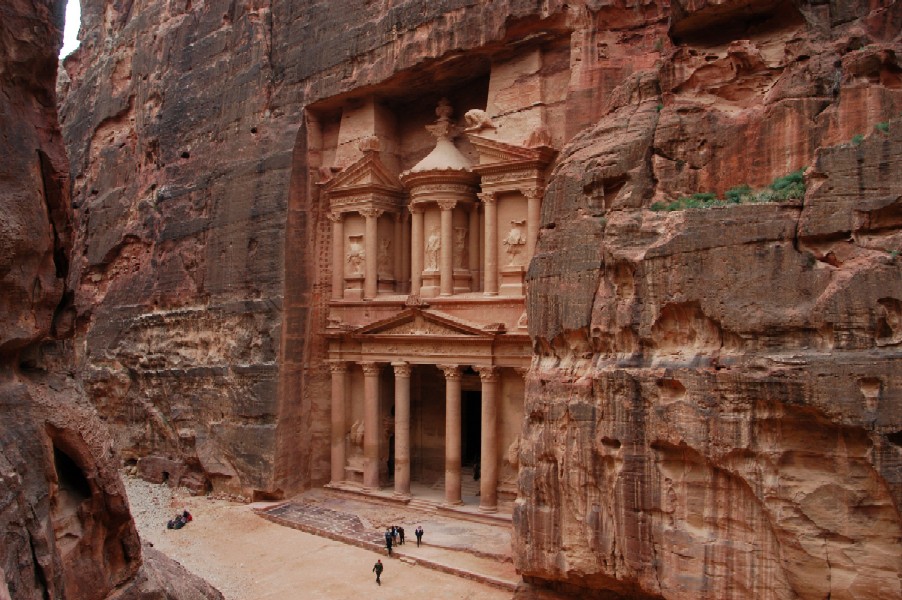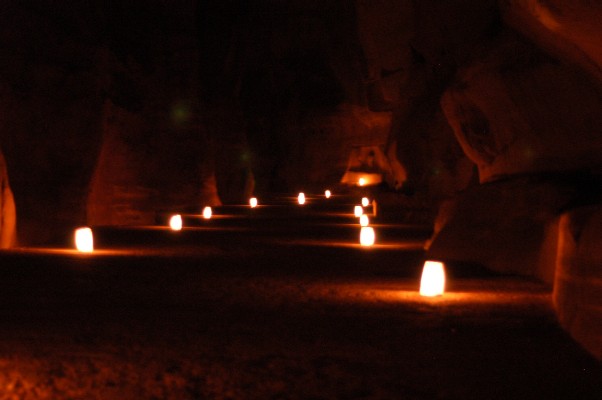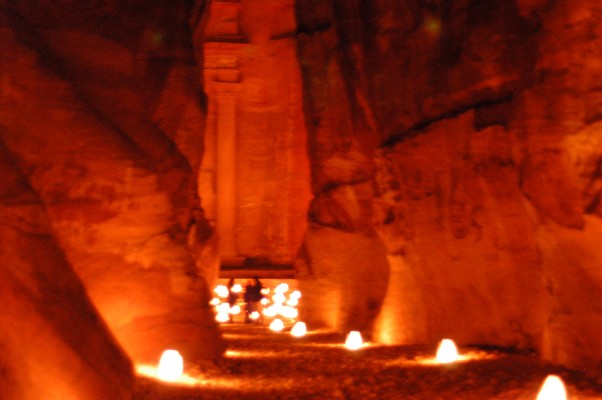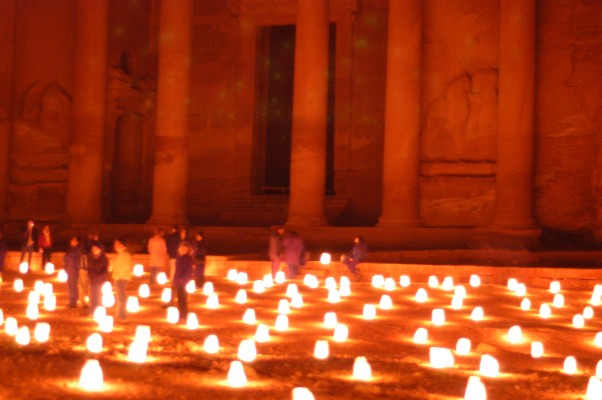February 19. PETRA "The Nabatean City by Day and Night" Breakfast was pretty good with a fried omelets with cheese and bread on the side, served with Nescafe. We left the hotel around 10:00 and opted to walk to the entrance of Petra. The hotel offered free transport to the gate but the weather was nice and it was all down hill so we walked. The tickets were at a 50% discount, in an effort to encourage tourism so we bought a three day ticket. It we wanted to visit longer than that it was free.
As we entered the gate a few touts tried to sell us on horseback rides to the Siq but at JD5 for a half mile it wasn't  very attractive. There gravel pathway was divided in half, one side for horses and the other for pedestrians. There were a few monuments to take in along the way, starting with the unusual god-blocks built by the Nabateans to protect the city's water supply. The were basically just big square blocks that popped up out of the landscape, the absoluteness of their square shape was the only thing that told they had been man-made. Like many peoples around the world the Nabateans created a religion that was relevant to their natural surroundings and rock was a key element, like mountains to the Sherpas of the Himalayas or the ocean to people in the pacific islands. To the Nabateans the rock could be the embodiment of a god or an altar that represented a contact point between the divine and the worldly. very attractive. There gravel pathway was divided in half, one side for horses and the other for pedestrians. There were a few monuments to take in along the way, starting with the unusual god-blocks built by the Nabateans to protect the city's water supply. The were basically just big square blocks that popped up out of the landscape, the absoluteness of their square shape was the only thing that told they had been man-made. Like many peoples around the world the Nabateans created a religion that was relevant to their natural surroundings and rock was a key element, like mountains to the Sherpas of the Himalayas or the ocean to people in the pacific islands. To the Nabateans the rock could be the embodiment of a god or an altar that represented a contact point between the divine and the worldly.
A blend of cultures from the region the Nabateans, as reflected in their monumental architecture, incorporated features of others cultures into their religion. Their head god, their creator Dushara, was later likened to the Greek god Zeus. Other important deities included Atargatis, the goddess of fertility; Allat, goddess of the moon; Manat, goddess of luck and fate; and al-Uzza, who became assimilated with the Egyptian goddess Isis, the Greek goddess Aphrodite, and the Roman goddess Venus. Allat, Manat, and al-Uzza were all mentioned in the Quran, suggesting that they were still actively worshipped in the 600s, at the time of the Prophet Muhammad. The term "the Lord is my rock" also appeared in the Old Testament.
Across from the collection of god rocks was the first carves facade we encountered at Petra, the Obelisk Tomb and Bab as-SiqTriclinium. The four obelisks, representing another form of god-rock, stood at the top and a Triclinium, a Roman dining hall with three benches, comprised the lower half. They were probably built at separate times but behind the obelisks was a cave of graves so the dining hall built below suggests that it was for banquets in honor of the dead.
When we reached the start of the Siq, the dramatic narrow gorge that served as the entrance to ancient Petra, the wider valley ended abruptly and cliffs rose to 150 meters on each side of the entrance. Horse back riders were not allowed in the Siq, presumably because dozens of crazy tourists tearing through the narrow passage like they did in Indiana Jones and the Last Crusade would be disastrous. But carriages were permitted so the touts were crowded at the entrance selling rides in little rickety carriages, JD25 to go 1200 meters. We enjoyed the peaceful serenity of walking the Siq. There weren't many tourists and most of the way through the winding gorge we were alone, except for the occasional carriage tearing past us. The pathway was paved and the echo of our footsteps bounced off of the walls. The Nabateans had carved a water channel into the left side of the gorge and the remains of a terracotta water pipe was still left on a section of the right side. At one point the remains of two merchants leading a camels each were faintly carved into the wall. The legs of each would have once connected the upper overhang with the lower one but today the two sets of sandals and four cleft hooves are all that remain at the edge of the water channel. A few niches and shrines were carved into the walls along the way with one free-standing shrine about half way through. The path occasionally gave way to the old cobblestone pathway of the Nabateans and towards the end the paved walkway came to and end and it turned into dirt. Soon after you stepped into this final stretch you came upon one of Petra's most striking sights, the view of the Treasury through the end of the Siq. The enormous facade of the temple carved right into the facing cliff was stunning and created an image that evoked the exotic romanticism of Petra in antiquity. It made everyone stop dead in their tracks as their chins dropped. Even having seen the image flashed on the movie screen of Indiana Jones didn't prepare me for the actual encounter. Movie images are so often doctored to create a more dramatic impression but not even Hollywood needed to improve upon this! the Siq, presumably because dozens of crazy tourists tearing through the narrow passage like they did in Indiana Jones and the Last Crusade would be disastrous. But carriages were permitted so the touts were crowded at the entrance selling rides in little rickety carriages, JD25 to go 1200 meters. We enjoyed the peaceful serenity of walking the Siq. There weren't many tourists and most of the way through the winding gorge we were alone, except for the occasional carriage tearing past us. The pathway was paved and the echo of our footsteps bounced off of the walls. The Nabateans had carved a water channel into the left side of the gorge and the remains of a terracotta water pipe was still left on a section of the right side. At one point the remains of two merchants leading a camels each were faintly carved into the wall. The legs of each would have once connected the upper overhang with the lower one but today the two sets of sandals and four cleft hooves are all that remain at the edge of the water channel. A few niches and shrines were carved into the walls along the way with one free-standing shrine about half way through. The path occasionally gave way to the old cobblestone pathway of the Nabateans and towards the end the paved walkway came to and end and it turned into dirt. Soon after you stepped into this final stretch you came upon one of Petra's most striking sights, the view of the Treasury through the end of the Siq. The enormous facade of the temple carved right into the facing cliff was stunning and created an image that evoked the exotic romanticism of Petra in antiquity. It made everyone stop dead in their tracks as their chins dropped. Even having seen the image flashed on the movie screen of Indiana Jones didn't prepare me for the actual encounter. Movie images are so often doctored to create a more dramatic impression but not even Hollywood needed to improve upon this!
We emerged from the Siq before the awesome Khaznet al-Faroum, or Pharoah's Treasury, standing forty meters high and thirty meters wide. The high walled valley surrounding the monument protected it form erosion and it stood as impressive as ever. The carvings have suffered damage but unlike other monuments in Petra the sharp lines of the broken pediment (a rooftop that is split in the middle) and the austere columns have remained unaffected by the winds of time. The images reflected Dashura and the Egyptian goddess Isis. The mounted riders at the bottom of the temple are Castor and Pollux, sons of Zeus. The Bedouin people of the wadi named the temple the "Treasury" after the folk story that the Pharaoh, chasing the Israelites after the Exodus, became wearing of carrying his treasury and left it encased in the massive urn that towers on the top of the monument. Bedouin marksmen tried to shatter the urn to release the treasure but only succeeded in scaring the facade. In fact the Treasury it thought to be a kind of tomb-temple as a basin is present at the front that would suggest a place for ritual washing, a feature only replicated in Petra's High Place of Sacrifice. Unlike Indiana Jones the interior was just a simple square chamber with smaller chambers to the sides. It was an incredible piece of work. Carved from the top down right out of the side of the cliff the structure was completely unsupported in any way. Even the magnificent columns were just for look s. s.
The temple is usually dated to the 1st century B.C. and its columns and gods reflect Mediterranean influences. First mentioned around 647 B.C. the Nabateans became a powerful entity in the Middle East and by 80 B.C. their empire extended as far as Damascus. They defeated the Greeks and to avoid further conflict were able to purchase peace with them. They did the same with the Romans in 62 B.C. Strategically located between Syria, Arabia, Egypt, and East Asia and the Mediterranean the Nabateans became wealthy traders but when overland routes for trade lost favor to sea transport their wealth declined and their last king died the Nabatean Kingdom peacefully passed to the Romans.
We climbed up to a small plateau about two-thirds of the way up the wall that faced the Treasury and looked down over the fabulous monument. Two local Bedouin children were happy to help us find the right path, handing us a small stratified rock from the area. We were sure that they wanted some money but they never asked for anything. From the end of the wadi, where the Treasury stood, the Outer Siq, a wider wadi, led to the main part of ancient Petra. On both sides old temples were blurred into the cliff sides, worn away by the elements, their drooping facades looking like layered wax melting into the ground. As the wadi opened up there was a collection of souvenir tents and tea shops. A few random people were walking around with their hands full of bracelets and necklaces shouting "One JD!". We moved past quickly and found ourselves facing a massive amphitheater, already partially eclipsed from the sun by the high surrounding cliffs. The stratified rock beautifully cut across the seats almost making them look like they were oozing down hill. The Romans refurbished it when they took over but the basic design was Hellenistic and was almost entirely carved out of the mountainside. As much time it would take to build a theater from blocks it is even more unimaginable that something this large was carved out of stone in its present form. It was large enough to have held up to 8500 people.
Not much further up the valley the cliffs widened from each other and the landscape opened up to expansive desert. A colonnade street led across the wide valley valley another stretch of cliffs with narrow wadis. Only a handful of columns and the remains of a few buildings still show what the grand main street would have once looked like. Petra is still considered relatively unexcavated territory and at one time the land on both sides of the colonnade would have been filled with markets, houses and buildings. Even on the farthest cliffs tombs carved into the rock could be seen. It will be interesting to see what archeologists are able to unearth from this expansive terrain.
Looking back from the colonnade street the looming East Cliff revealed some of Petra's most beautiful facades. They were no a match for the Treasury but together created a fantastic image. The remains of a nyphaeum, a Roman public fountain dedicated to water nymphs and decorated with statues, stood along the river that paralleled the colonnade street. At the end of the main street stood the most in tact  structure of the 'downtown' area, the Qasr al-Bint or Palace of the Pharoah's Daughter, another name derived from a Bedouin tale. Ironically, there is some indication that the temple was linked to the daughter of a powerful man. It was still in bad need of further restoration but the high walls helped create the image of a row of buildings that would have once stood in the area. Behind the start of another cliff temple could be seen in the rock. Just the pediment was complete and the top of the roof underneath but it demonstrated the logic in building from the top down as the un-carved rock would have provided the carvers with a place to stand while they worked their way down. structure of the 'downtown' area, the Qasr al-Bint or Palace of the Pharoah's Daughter, another name derived from a Bedouin tale. Ironically, there is some indication that the temple was linked to the daughter of a powerful man. It was still in bad need of further restoration but the high walls helped create the image of a row of buildings that would have once stood in the area. Behind the start of another cliff temple could be seen in the rock. Just the pediment was complete and the top of the roof underneath but it demonstrated the logic in building from the top down as the un-carved rock would have provided the carvers with a place to stand while they worked their way down.
Camel and donkey men were everywhere inside Petra, periodically hitting people up for "air-conditioned taxi" rides to the entrance or the Monastery (another important facade). And, thanks to the Crowne Plaza a neat little buffet restaurant was attached to the Petra museum. We didn't splash out for the lunch but the attendant supervised bathrooms were a treat. That was as far as our first day in Petra took us. We started back towards the entrance, fending off the donkey guys and the jewlery vendors, making the slow gradual ascent back through the colonnade street, the Outer Siq, the Siq and finally the Bab as-Siq. We were determined to get back by 3:00 so we could catch the visitors' center before it closed and sign up for the Petra By Night experience.
It had been a long enough day and left me, in particular, tired. As we reached the visitors center I motivated myself by focusing on a milk shake at the Mövenpick Hotel just outside the gate. The guidebook raved about the opulent atrium and the splashing out on a coffee and milk shake was worth the opportunity to sit in this beautiful spot. A high ceiling with wooden beams stretched to the glass skylight above providing soft natural light. Mother-of-pearl inlaid furniture filled the room with abundant colorful pillows. The tile floor was cooling. It was quiet and peaceful place that evoked the romance of the Middle East, a perfect way to end our visit to Petra.
Feeling just slightly boosted after our snack we slogged our way back to our hotel. The Petra By Night tour started at 8pm so we rested up in the afternoon and had dinner at our hotel. We had them take drive us back down this time and when we arrived there were hardly any other people around. We were hopeful that it would be a small group but as we got closer to departing more and more people materialized until we had a sizable group. It was freezing cold so many people were warmly dressed in hats, mittens and scarves.
As we started down the Bab al-Siq there were paper bags with candles inside lining the pathway and carefully positioned in some of the monuments, providing and soft orange glow. When we reached the entrance to the Siq our guide, Mr. Mohammad, tried to prepare people for our serene experience by discouraging them from talking and walking single file but we suspected it was to little avail. We watched a couple of people squeak by and just start down the candle lit Siq on their own but when Mr. Mohammad signaled for everyone to go, instead of walking quietly or in single file, they moved in one big noisy hoard. That wasn't what we had come out to experience so we just hung back until everyone had disappeared around the first  corner. They moved swiftly and soon we couldn't hear them all. It was like having the whole Siq to ourselves. We could hear the clapping of our feet against the ground as we followed the snaking path of corner. They moved swiftly and soon we couldn't hear them all. It was like having the whole Siq to ourselves. We could hear the clapping of our feet against the ground as we followed the snaking path of
candles through the narrow gorge. It was a dark night and the candle light just provided a dim glow, giving the Siq a magical ambiance. When the Treasury peeked out through the end of the gorge a sea of lights at the base of the facade made the monument look surreal, an orange glow emanating upwards from the ground. People were quietly standing along the wall as a flutist playing from within the Treasury, a mystical sweet sound resounding off of the stone walls. He slowly emerged into the rows of candles and moved carefully towards the crowd. A few dark silhouettes went out to meet him while a stray cat bolted back and forth across the mysterious landscape. When he stopped everyone clapped as attendants came out with trays of herbal tea - thyme, sage, chamomile tea with honey. We wove our way through the candles and explored the Treasury up close. Unlike the images we'd seen of lit candles within the monument they only came up to the base of the steps but still created a fantastic scene. We sat quietly until people started to leave. Mr. Mohammad told Rob that they had to stop putting candles inside the Treasury because people repeatedly disregarded the boundaries of the temple and tried to sneak inside. We were the last to leave except for three loud Americans that laughed and yelled their way back to the entrance (sadly typical). Still, it had been a magical experience that greatly enhanced our visit to Petra.
Back at the visitors center the guy at the desk said he couldn't call our hotel to come pick us up, as our hotel had said they would, so we just caught a cab back up the hill. The humming was well under way in our room and the shower was pathetic but it had been a wonderful first day at Petra and nothing could take away from that. |
GREECE
Athens
Jan 27-Feb 4
EGYPT
Cairo
Feb 4
Feb 5
Feb 6
Feb 7
Aswan
Feb 8
Feb 9
Feb 10
Luxor
Feb 11
Feb 12
Feb 13
Feb 14
Feb 15
Nuweiba
Feb 16-17
JORDAN
Petra
Feb 18
Feb 19
Feb 20
Feb 21
Amman
Feb 22
Feb 23-24
Feb 25
Feb 26
Feb 27
Feb 28
Feb 29-Mar 1
Dead Sea
Mar 2
Mar 3
ISRAEL
Eilat
Mar 4
EGYPT
Cairo
Mar 5
Mar 6
Mar 7
Mar 8
GREECE
Athens
Mar 9
Santorini
Mar 10
Mar 11
Mar 12-13
Crete
Mar 14
Mar 15-16
Mar 17-21
Athens
Mar 22
|

